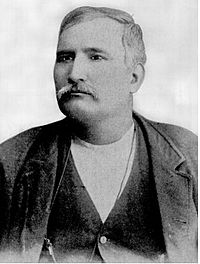John Leak Springston facts for kids
John Leak Springston "Oo ne qua ti" ᎤᏁᏆᏘ (1844–1929) was a Cherokee man known as an important Indian activist. During his life, he worked as a Cherokee Interpreter, Editor, Lawyer, and a leader in the Keetoowah Revivalist movement.
Springston was born in the fall of 1844 in Indian Territory. This area is now part of Oklahoma. His parents, Anderson Springston and Sallie Eliot, were Cherokees. They had to walk about 600 miles on the Trail of Tears from Alabama to Indian Territory.
After this difficult journey, John's father, Anderson, became a lawyer in the Cherokee courts. As a young boy, John learned about tribal law and Cherokee culture from his father.
Contents
Early Life and Education
Young John Springston went to school in the Delaware District. He spoke Cherokee as his first language. He did not learn English until he was seven years old.
John was a very good speaker and writer. By the age of fifteen, he worked as a clerk and court reporter in the Saline District. He planned to study law at Shurtleff College in Illinois.
Service During the Civil War
Before John could go to law school, the American Civil War started. Indian Territory became involved in the war. John decided to join the Union Army to help.
He was part of the Third Regiment, Company I, of the Indian Home Guards. He fought in two major battles: Cabin Creek and Honey Springs. Because he spoke both Cherokee and English very well, he also worked as an Acting Interpreter at Fort Gibson.
Post-War Career and Family Life
After the Civil War, Springston worked as a translator and editor for the Cherokee Advocate. This was a weekly newspaper published in Tahlequah. He worked with important Cherokee leaders like William P. Ross. This job helped shape his political ideas.
His skills in writing and language soon caught the attention of Cherokee tribal officials. They offered him the job of Secretary to the Principal Chief. He also became the official Executive Translator. This new role gave him special access to all dealings between the Cherokee Nation and the United States government. It helped him learn a lot about how government works.
In 1867, Springston married Sarah Eliza Moseley, a Cherokee woman. They had two daughters, Ruth and Elizabeth. Sadly, Sarah became ill and died in 1872. In 1874, he married Amanda Williams in Tahlequah. They had two more daughters, Viola and Wenona. Amanda passed away in 1882. In 1886, he married for a third time to Alice Caroline Gray. They had his only son, William P. Boudinot Springston.
Cherokee Activism and Leadership
Because of his traditional upbringing, Springston believed in protecting the Cherokee Nation. He did not want the federal government to interfere in Indian Territory. He worked hard for a strong, independent Cherokee Nation for the rest of his life. He also strongly opposed slavery.
During the reconstruction era, many people who were not Cherokee came into the Cherokee Nation. Springston became concerned about this. He supported bringing back the ancient Keetoowah Society. This was a group that wanted to protect Cherokee ways. They opposed slavery and outsiders interfering in tribal matters.
Between 1880 and 1890, this secret society became very powerful in Indian Territory. It even helped decide who would be leaders in the Nation. During this time, Springston served as sheriff of the Saline District. He was also a clerk for the Cherokee senate. He wrote several books about Cherokee laws and treaties in both Cherokee Syllabary and English.
Later Career and Legacy
Springston left the Cherokee Advocate in 1886. However, he continued to work in newspapers. He became the editor of the Tahlequah Morning Sun. Two years later, he took an important job as an interpreter. This was for the United States court at Fort Smith. Judge Isaac C. Parker led this court. It handled all criminal cases in Indian Territory.
Springston also worked as the clerk of the senate and official interpreter. He held these roles during Chief Dennis Bushyhead's time as leader (1879-1887). Until he retired in 1925, he continued to practice law. He spent a lot of his time helping Indian veterans of the Civil War and the Spanish–American War get their pensions.
For some years, the Springston family lived in Sallisaw. John built a large home there near the Kansas City Southern Railroad station. This home, known as the Springston House, later became the first public school in Sallisaw.
After his third marriage, Springston moved to Vian. He was one of the main people who helped found that town. He spent his last years living with his son in Tulsa. He died in 1929 at the age of eighty-four. His son, William P. Boudinot Springston, gave John's important papers to the Oklahoma Historical Society, the Gilcrease Museum, and the University of Oklahoma. This was done to preserve them for future generations.


